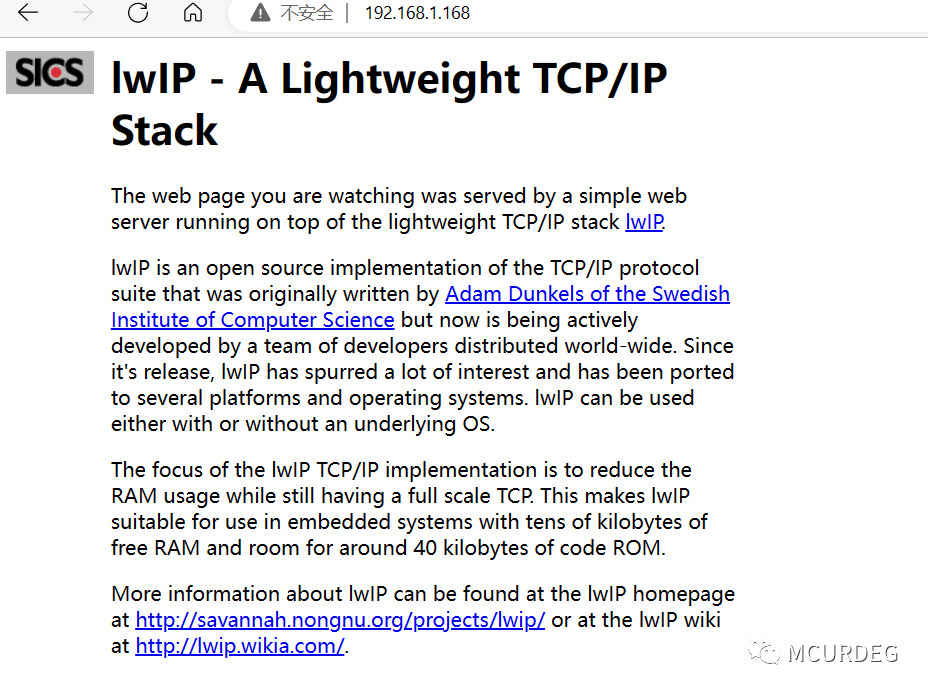参考正点原子的 网络实验10 NETCONN_WEBserver实验和《lwIP开发指南》。
开发环境:野火的stm32f407,rt-thread studio版本是: 2.2.6,stm32f4的资源包为0.2.2,rt-thread版本为4.0.3。
以RT-Thread中Lan8720和lwip协议栈的使用文章创建的工程为基础。
httpd(The Apache HTTP Server)的官方网址:
官方网址](https://httpd.apache.org/
在rtthread工程中新建文件夹webserver,存放webserver相关文件。
先对工程进行编译,正常通过。
需要修改的代码,过程如下:
rt-thread\components\net\lwip-2.0.2\src\include\lwip\apps\httpd_opts.h 文件中的宏定义
LWIP_HTTPD_CGI 默认为0,改为1
LWIP_HTTPD_SSI 默认为0,改为1
HTTPD_USE_CUSTOM_FSDATA默认为0
LWIP_HTTPD_DYNAMIC_FILE_READ默认为0,改为1
2. 将 rt-thread\components\net\lwip-2.0.2\src\apps\httpd文件夹 添加构建
3. httpd文件夹下的fsdata.c 排除构建。
4. 在主函数中增加如下代码:
extern void httpd_init(void); httpd_init(); while (count++) { LOG_D("Hello RT-Thread!"); rt_thread_mdelay(10000); }编译正常,下载到开发板,在浏览器输入ip地址,效果如图1:

如何使用自己的网页呢?
修改如下:
将rt-thread\components\net\lwip-2.0.2\src\apps\httpd文件夹下的fsdata.c替换成自己的fsdata.c,(使用makefsdata.exe这个软件自动生成即可)。
在webserve文件夹下创建httpd_cgi_ssi.c文件(CGI和SSI句柄函数)
代码如下:
#include <lwip/apps/httpd.h> #include "lwip/tcp.h" #include <lwip/apps/fs.h> #include <string.h> #include <stdlib.h> int LED1=0; int BEEP=0; #define NUM_CONFIG_CGI_URIS (sizeof(ppcURLs) / sizeof(tCGI)) #define NUM_CONFIG_SSI_TAGS (sizeof(ppcTAGs) / sizeof(char *)) //extern short Get_Temprate(void); //extern void RTC_Get_Time(u8 *hour,u8 *min,u8 *sec,u8 *ampm); //extern void RTC_Get_Date(u8 *year,u8 *month,u8 *date,u8 *week); //控制LED的CGI handler const char* LEDS_CGI_Handler(int iIndex, int iNumParams, char *pcParam[], char *pcValue[]); const char* BEEP_CGI_Handler(int iIndex,int iNumParams,char *pcParam[],char *pcValue[]); static const char *ppcTAGs[]= //SSI的Tag { "t", //ADC值 "w", //温度值 "h", //时间 "y" //日期 }; static const tCGI ppcURLs[]= //cgi程序 { {"/leds.cgi",LEDS_CGI_Handler}, {"/beep.cgi",BEEP_CGI_Handler}, }; //当web客户端请求浏览器的时候,使用此函数被CGI handler调用 static int FindCGIParameter(const char *pcToFind,char *pcParam[],int iNumParams) { int iLoop; for(iLoop = 0;iLoop < iNumParams;iLoop ++ ) { if(strcmp(pcToFind,pcParam[iLoop]) == 0) { return (iLoop); //返回 iLOOP } } return (-1); } //SSIHandlerÖ中adc处理函数 void ADC_Handler(char *pcInsert) { char Digit1=0, Digit2=0, Digit3=0, Digit4=0; static uint32_t ADCVal = 0; //ADCVal = Get_Adc_Average(5,10);//ADC1_CH5的电压值 ADCVal+=10; ADCVal=ADCVal%3000; //转换为 ADCVval * 0.8mv ADCVal = (uint32_t)(ADCVal * 0.8); Digit1= ADCVal/1000; Digit2= (ADCVal-(Digit1*1000))/100 ; Digit3= (ADCVal-((Digit1*1000)+(Digit2*100)))/10; Digit4= ADCVal -((Digit1*1000)+(Digit2*100)+ (Digit3*10)); /* 准备添加到html中的数据 */ *pcInsert = (char)(Digit1+0x30); *(pcInsert + 1) = (char)(Digit2+0x30); *(pcInsert + 2) = (char)(Digit3+0x30); *(pcInsert + 3) = (char)(Digit4+0x30); } //SSIHandler中需要用到的内部处理温度传感器 void Temperate_Handler(char *pcInsert) { char Digit1=0, Digit2=0, Digit3=0, Digit4=0,Digit5=0; static short Temperate = 0; //Temperate = Get_Temprate(); Temperate+=1.3; Digit1 = Temperate / 10000; Digit2 = (Temperate % 10000)/1000; Digit3 = (Temperate % 1000)/100 ; Digit4 = (Temperate % 100)/10; Digit5 = Temperate % 10; /* 准备添加到html中的数据 */ *pcInsert = (char)(Digit1+0x30); *(pcInsert+1) = (char)(Digit2+0x30); *(pcInsert+2) = (char)(Digit3+0x30); *(pcInsert+3) = '.'; *(pcInsert+4) = (char)(Digit4+0x30); *(pcInsert+5) = (char)(Digit5+0x30); } //SSIHandler中需要用到的处理RTC日时间的函数 void RTCTime_Handler(char *pcInsert) { static uint8_t hour,min,sec,ampm; hour++; min++; sec++; ampm++; //RTC_Get_Time(&hour,&min,&sec,&m); /* 准备添加到html中的数据 */ *pcInsert = (char)((hour/10) + 0x30); *(pcInsert+1) = (char)((hour%10) + 0x30); *(pcInsert+2) = ':'; *(pcInsert+3) = (char)((min/10) + 0x30); *(pcInsert+4) = (char)((min%10) + 0x30); *(pcInsert+5) = ':'; *(pcInsert+6) = (char)((sec/10) + 0x30); *(pcInsert+7) = (char)((sec%10) + 0x30); } //SSIHandler中需要用到的处理RTC日期的函数 void RTCdate_Handler(char *pcInsert) { static uint8_t year,month,date,week; //RTC_Get_Date(&year,&month,&date,&week); year++; month++; date++; week++; /* 准备添加到html中的数据 */ *pcInsert = '2'; *(pcInsert+1) = '0'; *(pcInsert+2) = (char)((year/10) + 0x30); *(pcInsert+3) = (char)((year%10) + 0x30); *(pcInsert+4) = '-'; *(pcInsert+5) = (char)((month/10) + 0x30); *(pcInsert+6) = (char)((month%10) + 0x30); *(pcInsert+7) = '-'; *(pcInsert+8) = (char)((date/10) + 0x30); *(pcInsert+9) = (char)((date%10) + 0x30); *(pcInsert+10) = ' '; *(pcInsert+11) = 'w'; *(pcInsert+12) = 'e'; *(pcInsert+13) = 'e'; *(pcInsert+14) = 'k'; *(pcInsert+15) = ':'; *(pcInsert+16) = (char)(week + 0x30); } //SSI的 Handler 句柄 static u16_t SSIHandler(int iIndex,char *pcInsert,int iInsertLen) { switch(iIndex) { case 0: ADC_Handler(pcInsert); break; case 1: Temperate_Handler(pcInsert); break; case 2: RTCTime_Handler(pcInsert); break; case 3: RTCdate_Handler(pcInsert); break; } return strlen(pcInsert); } //CGI LED控制句柄 const char* LEDS_CGI_Handler(int iIndex, int iNumParams, char *pcParam[], char *pcValue[]) { uint8_t i=0; //注意根据自己的GET的参数的多少来选择i值范围 iIndex = FindCGIParameter("LED1",pcParam,iNumParams); //找到LED的索引号 //只有一个CGI句柄 iIndex=0 if (iIndex != -1) { LED1=1; for (i=0; i<iNumParams; i++) //检查CGI参数: example GET /leds.cgi?led=2&led=4 */ { if (strcmp(pcParam[i] , "LED1")==0) //检查参数"led" { if(strcmp(pcValue[i], "LED1ON") ==0) { LED1=0; rt_kprintf("LED1ON\n"); } else if(strcmp(pcValue[i],"LED1OFF") == 0) { LED1=1; rt_kprintf("LED1OFF\n"); } } } } if(LED1 == 0 && BEEP == 0) return "/STM32F407LED_ON_BEEP_OFF.shtml"; // else if(LED1 == 0 && BEEP == 1) return "/STM32F407LED_ON_BEEP_ON.shtml"; // else if(LED1 == 1 && BEEP == 1) return "/STM32F407LED_OFF_BEEP_ON.shtml"; // else return "/STM32F407LED_OFF_BEEP_OFF.shtml"; // } //BEEP的CGI控制句柄 const char *BEEP_CGI_Handler(int iIndex,int iNumParams,char *pcParam[],char *pcValue[]) { uint8_t i=0; iIndex = FindCGIParameter("BEEP",pcParam,iNumParams); //找到BEEP的索引号 if(iIndex != -1) //找到BEEP的索引号 { BEEP=0; // for(i = 0;i < iNumParams;i++) { if(strcmp(pcParam[i],"BEEP") == 0) // { if(strcmp(pcValue[i],"BEEPON") == 0) // { BEEP = 1; rt_kprintf("BEEPON\n"); } else if(strcmp(pcValue[i],"BEEPOFF") == 0) // { BEEP = 0; rt_kprintf("BEEPOFF\n"); } } } } if(LED1 == 0 && BEEP == 0) return "/STM32F407LED_ON_BEEP_OFF.shtml"; // else if(LED1 == 0 && BEEP == 1) return "/STM32F407LED_ON_BEEP_ON.shtml"; // else if(LED1 == 1 && BEEP == 1) return "/STM32F407LED_OFF_BEEP_ON.shtml"; // else return "/STM32F407LED_OFF_BEEP_OFF.shtml"; // } //SSI句柄初始化 void httpd_ssi_init(void) { //配置内部温度传感器的SSI句柄 http_set_ssi_handler(SSIHandler,ppcTAGs,NUM_CONFIG_SSI_TAGS); } //CGI句柄初始化 void httpd_cgi_init(void) { //配置CGI句柄 LEDs control CGI) */ http_set_cgi_handlers(ppcURLs, NUM_CONFIG_CGI_URIS); }主函数中代码如下:
extern void httpd_ssi_init(void); extern void httpd_cgi_init(void); extern void httpd_init(void); httpd_cgi_init(); httpd_ssi_init(); httpd_init();重新编译,下载到开发板,在浏览器输入开发板ip地址,查看效果。效果如图2:

LWIP HTTP 协议中默认只支持GET方法 但是一般提交表单时都用POST方法 而LWIPPOST方案需要自己实现 不过LWIP已经需要实现的函数声明在httpd.h中了。post的例程:
lwip/post_example.c at master · particle-iot/lwip (github.com)

